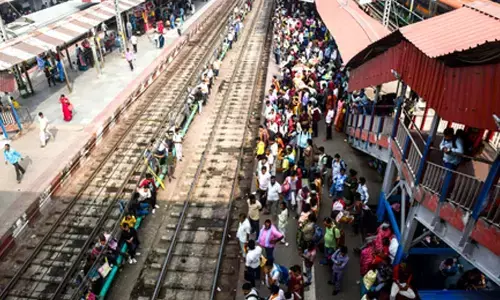Harvest happiness

It was the beginning of summer and I was at the Haldwani bus stand in Uttarakhand, trying to search for a seat in a bus that was heading back to the plains.
It was the beginning of summer and I was at the Haldwani bus stand in Uttarakhand, trying to search for a seat in a bus that was heading back to the plains.
A plethora of carts sold some of the biggest plums and peaches I had ever seen. I asked one vendor from where the fruits had come.
“Ramgarh.” He replied.
“How far is it from here?” I asked again.
“Hardly 3 hours by bus. Even less, if you have your own vehicle.”
Immediately my plans changed right then and there. A few minutes later I was seated in the back seat of a mini-bus heading to Ramgarh and exactly 3 hours later, I was at my destination.
Just after the market area ended, the orchards began. Even from outside the boundary wall, I could spot hordes of plump plums hanging from the branches. By then a crowd had gathered around me and sensing my interest, a young man (who later turned out to be the co-owner of the orchard) volunteered to take me inside my much-pursued paradise.
As I plucked a handful of plums and began gobbling the plumpest (and of course the juiciest) one, It felt as if I was living a dream. After being content with plums, I began to hunt for my favourite fruit- the apricots. We walked a little and ended up at an apricot orchard. The best part of the cloudy afternoon was spent binging on these yellow beauties.
From the orchard owner, I learnt that Ramgarh is the supplier of a wide variety of fruits across India with the produce also being exported. Peaches, apricots, plums, pears and cherries abound for acres together in Ramgarh. The fruits start getting ripe by around mid-April and the harvest season lasts till end September. When the orchard owner asks me if I would like to eat more fruits, I greedily nod in the affirmative.
As the sweltering summer with its sultriness and other nuances sets in, who doesn’t feel like escaping to the coolness of the hills to breathe fresh cool air amid pure, totally unpolluted environment? However, if you are a full-fledged family, then there are challenges as travelling with kids isn’t easy. One needs to worry about age-appropriate attractions and activities to keep them gainfully engaged.
In such a situation, imagine children and adults spending balmy mornings on a farm picking (and after that eating) spree and feasting on the delicious fruit! Isn’t there a lot of joy in connecting with the fruit that we pick to eat?.
So this summer, how about going fruit-picking across orchards in the Himalayas?
Most orchards allow visitors to pick fruit for free, and charge only for what’s consumed. Some of them even offer accommodation. There is no greater pleasure than to just pick fruits from the branches and devour them for breakfast, lunch and dinner.
Ramgarh, a beautiful hill station situated in Uttarakhand is comprised of a bunch of hamlets spread across fruit- and forest-laden hill slopes, with a ‘Malla Ramgarh’ on top and a ‘Talla Ramgarh’ at the bottom. It is also known as the Fruit bowl of Kumaon as it is home to many orchards of apricots, plums, peaches and apples. A long road meanders from top to bottom. The best way to explore the place is to walk, walk and walk. Follow the shortcut paths the locals take and feast ( with the plucked fruits) by the stream that runs through the orchards bordering the sleepy hamlets.
And if you have tanked yourself up (of course with fruits) to your heart’s content, just grab a rug and curl up on a grassy knoll. The only sound that’ll interrupt the peace is the tinkle of cowbells. The hills around Ramgarh also offer a plethora of picnic spots. There are a number of family-run-farm stays located in the fruit belts of the great mountain range. They offer an ideal place to rejoice, meditate or simply sit back and absorb the nature’s magnificence. The homegrown food and warm hospitality will make you feel at home all along.
Tucked away in the Garhwal Himalayas, en-route to the popular pilgrimage shrine of Gangotri, is quaint little mountain village in Uttarakhand – Harsil. Set amidst pine trees and apple orchards, the town is famous for its local apple produce. A British, Fredrick E Wilson had planted the first apple tree here in the 19th century and acquainted the people of Harshil with apple cultivation.
He also married local girls and settled here because of which he earned the nickname “Pahari ( belonging to the hills) Wilson.” A brand of apples grown here are now named after his name and called “Wilson Apples”. Just imagine the sight of breath-taking red, ripened and juicy apples. Tempting, isn’t it? While at Harsil, don’t forget to relish upon the other local breeds of apples named as Royal Delicious, Red Delicious, Golden Delicious and Early Sunberry.
After Uttarakhand, let’s head to Himachal Pradesh to look for the favoured fruit picking hot spots. Heading northeast from Shimla, the former summer capital of the British Raj and now the capital of the hilly state of Himachal Pradesh --Highway 22 still follows the old Hindustan-Tibet trade route.
Townships on the apple trail include Narkanda, Thanedar, Theog and Rampur. The six-month apple season, from spring flowering to the last harvest in late September, is the best time to be there for fruits. Enterprising roadside vendors sell apples juiced, whole or sliced on a plate; while the local bakers make delicious fresh apple cake.
It was along this route that the British first settled at Thanedar in 1822, attracted to the climate that provided relief from the heat of the plains and enabled familiar plants to grow. English country garden flowers – roses, honeysuckle and dahlias – still give gorgeous spring and summer displays, though the small orchards of Pippin apples planted by the early British settlers have almost vanished.
It was only after the introduction of the sweeter apples more suited to Indian tastes that the fruit industry really took off. Samuel Evans Stokes, son of a wealthy American Quaker family and a convert to Hinduism, built his estate in 1912. He also intentionally and strategically changed local history by importing the first Red Delicious apples from the US in 1916.
Better known in India as Satyanand Stokes, Samuel became part of Mahatma Gandhi’s inner circle. His vision for a sustainable local economy was a benign colonialism that worked and apples became the area’s primary produce. Today the small rural community of Thanedar is home to the century-old orchards and farms that are central to the region’s history of fruitful apple harvests. Farming families in this part of the Himalayas have better health, education and prospects than many other rural communities in India.
On clear days, the orchard landscapes alongside Highway 22 are a photographer’s dream. Steep slopes planted with a plethora of fruit-laden trees rise and fall on either side as the narrow road zigzags through the progressively spectacular landscape with the snow-capped Himalayas in the distance. Orchards here have been planted pragmatically, stepping higgledy-piggledy uphill or weaving a line along thin terraces cut into the hillsides.
In this region, there are many ecological and organic farm stays that offer the most refreshing getaways and carry enough options of activities to keep all members of the family occupied. There are also community-based sustainable organic fruit farms which also offer one opportunity to engage and explore everything about the fruits. Touch the earth, know your fruit, feel its freshness and sing in chorus with the birds. Explore the privileges that the city life has snatched from your kids. Explore the unblemished countryside life where the real India resides.
So this summer, get off the tourist trail. Go on a fruitful holiday with your kids. No matter which orchard you end up at, you are sure to find it well worth the trip just to be able to eat delectable fruits straight off the trees. The lure of fruit picking will not just feed your own cravings but also help promote an important aspect of India’s fruit growing industry – agro-tourism. So just go ahead and head to India’s orchards in the coolness of the Himalayas and enjoy the fruits of your labour, literally!
















